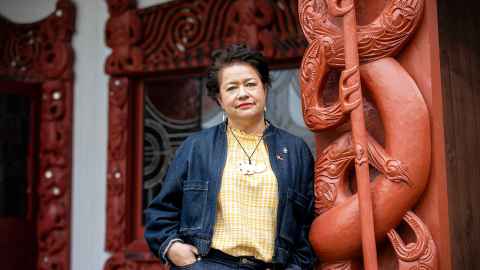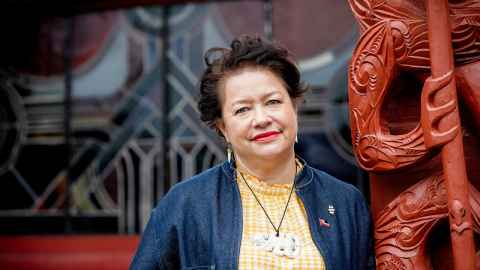Professor Ngarino Ellis: He toi, he tangata
14 October 2025
Ngarino Ellis is the first Māori professor of art history in Aotearoa. Her inaugural lecture is on 15 October.

It’s a Tuesday afternoon, and Ngarino Ellis (Ngāpuhi, Ngāti Porou) is preparing for one of the biggest milestones of her academic life – her inaugural lecture as professor of art history at Waipapa Taumata Rau, University of Auckland.
The sounds of 90s R’n’B fill her office. “It’s an essential in here,” she laughs. “It keeps me focused.”
It’s a fitting soundtrack for a woman whose life has been defined by rhythm – between worlds, between disciplines, and between generations. On 15 October, Ellis will deliver her inaugural lecture, 'Ki wiwi, ki wawa – Taonga and the power of Māori art history', at the University's Building 201.
A life shaped by whakapapa and the world
Ellis grew up between cultures – Māori and Pākehā, Aotearoa and Europe – and between communities as different as Rāwhiti and Northampton.
“I’m very proudly from two iwi, Ngāpuhi and Ngāti Porou. But I’ve lived a really unique life where I’ve lived in many places,” she says.
“I was born in Kawakawa, but mum is from Rāwhiti, so we spent a lot of time there and it was just paradise growing up. Every summer we’d be up North from the moment school finished until it started again. We’d be climbing trees, swimming, playing bullrush with cousins, and only going home when you were hungry. It was that kind of idyllic 70s childhood.”
Her father, Robert Ellis, an Elam alumnus and a professor at the School of Fine Arts, and her mother, Elizabeth Ellis MNZM – recently named the 2025 Senior New Zealander of the Year – gave their daughters both creative and cultural grounding.
“I’m a twin, my sister’s name is Hana and we have spent all of our lives together, even to this very day.”
“Mum’s dad was a freezing worker who worked for 60 years, and we weren’t allowed to leave Kawakawa until we got baptised because my grandmother was very staunchly Anglican."
“Dad was lecturing at Elam and would commute to Kawakawa where Mum was living during her pregnancy with us. Luckily my nanny was a midwife.”
When they settled into Auckland city life, Ellis’s father made sure his daughters stayed connected to both sides of their heritage.
“From the age of 18 months, we went back to England every five years for a year. Dad wanted us to know his parents and his side of the family. We’d live with them in Northampton, then drive through France and down to Spain, where we lived for months at a time in a little village called Valencina, outside Seville.”
It was there, surrounded by a Spanish-speaking community, that Ellis found another home.
“When I was seven, I was fluent in Spanish and used to go off every day to get the family’s food. My sister knew more Spanish, but I was the talker,” she laughs.
“We became really close with the people there, they became our aunts and uncles. When I took my own children back with mum after 20 years, it felt like going home again. The food, the people, the Spanish – just came out again. It was beautiful.”
She reflects that travel taught her more than language and shaped her sense of belonging.
“Being in communities that don’t speak English gives you a kind of mobility of identity. It made our little family unit – mum, dad, Hana and me – very close.”
Back in Auckland, Ellis recalls having her first experience of understanding herself as Māori.
“At Rāwhiti, we never thought about difference, it was just normal. But when I got to intermediate, we did this horrible colonial play, and suddenly I realised: me and all my mates, we were Māori. That was the first time I became aware of identity in that way.”
For me, art history is human history – it’s Māori history. It’s storytelling. We use whakapapa, landscapes, and people to navigate those histories.

From law to art history: a turning point
After finishing school, the twins went overseas again, completing Massey University correspondence papers in French and English.
“We thought we’d be diplomats, it seemed like the dream, to live overseas and represent Aotearoa.”
On returning home, a Māori Studies adviser suggested they study law. “So we did a double degree in Law and Arts. I took art history and Spanish. Law was intense. I did criminal, family, and international law, the humanistic side of things, not the money side. I’m terrible at land law though!”
But something in her heart pulled her toward art history. “I thought, I don’t know how I can help Māori if I’m not at least doing something connected to our art, our stories. I’d spent all these years in law but I really enjoyed art history.”
Her lecturer, Professor Ngahuia Te Awekotuku, offered her a tutorship. “She said, ‘I’ve got a position for you’. I was doing my masters part time and working part time but that was it. I left law and started teaching art history while writing my masters.”
But it was once Ellis embarked on her PhD that she really felt “unshackled” from law. “That’s when I knew I was exactly where I was meant to be.”
Her work since has shaped how Māori art history is understood in Aotearoa and globally. She is also the only Māori academic in an Art History department in the country.
In 2019, she received the Ako Aotearoa Tertiary Teaching Excellence Award for Sustained Excellence in Tertiary Teaching – Kaupapa Māori, acknowledging her leadership in creating spaces of manaakitanga and rangatiratanga within the academy.
The following year, Ellis was honoured by the Royal Society Te Apārangi with the Early Career Research Excellence Award for Humanities for her groundbreaking book A Whakapapa of Tradition: One Hundred Years of Ngāti Porou Carving, 1830–1930. The book earned multiple literary accolades, including the Judith Binney Best First Book at the Ockham New Zealand Book Awards, and Best Māori Art Book at the Ngā Kupu Ora Awards in 2017.
Ellis' scholarship has continued to be celebrated, most recently through Toi Te Mana: An Indigenous History of Māori Art (2024, co-authored with Deidre Brown and Jonathan Mane-Wheoki), which won the Illustrated Non-Fiction Award at the 2025 Ockhams.
“For me, art history is human history – it’s Māori history. It’s storytelling. We use whakapapa, landscapes, and people to navigate those histories.
“When I started this job, there were maybe four or five Māori art historians across the country. Now there’s only me. That doesn’t mean art history is less important – it means we have work to do.”
Her focus now is on holding space and lifting others. “It’s about creating room for new voices, bringing people over from history or anthropology, showing them the potential of Māori art history.”
She describes art history as “relatively young” as a university discipline. “But of course, we’ve been thinking about art and our communities for hundreds of years. Our chiefs were our curators, our patrons, our artists. The exciting part now is exploring what Māori art history might look like and how we tell those stories.”
Whānau first, always
Through every chapter of her life, Ellis has kept whānau at the centre. “I am māmā first, before I am a professor or a researcher,” she says firmly.
"I have three children, Emere, 24, Hana, 21, and Takimoana, 18. I’ll drop anything for them."
"Nothing is too big or too small, my world revolves around them, no matter what. I was a very hands-on mum when my children were small; I’m very old school where I’ve done everything. You exhaust yourself but that’s what you do. I love the noise and the craziness that they bring, and I don’t ever want that to change.”
She gestures around her office: “This is just work.”
Ellis' upbringing taught her the importance of service. “When I was starting my masters, my grandmother had a series of strokes. I’d go to my aunt’s before class to help her get ready for her day, get her up, dressed, hair done. She was in her 90s. Then I’d go back after uni and help her into bed. That taught me what it means to serve.”
Her grandparents, she says, were “seminal” in shaping her worldview. “They always said: 'Go back, give back'. I think that’s what I do now through my teaching and publishing, trying to honour them.”
Professor Ngarino Ellis will deliver her inaugural lecture on Wednesday 15 October, at Waipapa Taumata Rau, University of Auckland.
- When: Wednesday 15 October
- Where: Building 201, Room 440
- Time: 6–7pm
Register here.
Media contact
Te Rina Ruka-Triponel | Kaitohutohu Pāpāho Māori
E: te.rina.triponel@auckland.ac.nz